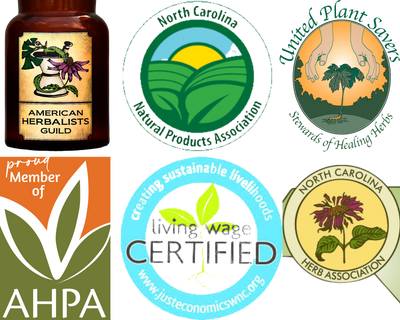Are Standardized Extracts Better?
by Nancy and Michael Phillips
Philosophy enters deeply into the debate on standardizing herbal preparations. People oriented towards a scientific point of view feel the need to quantify health-giving possibilities by knowing the concentration of the chosen active principle (constituent) used to achieve proven results. Others view synergy and spirit as working in ways we may not fully comprehend but have certainly observed with whole plant preparations that embrace health, often in more ways than one.
Standardization generally refers to chemical extraction of the deemed active constituent. Two assumptions come immediately to the fore. Does one ingredient alone reflect the beneficial power in a given plant? And does this ingredient become more potent in a concentrated extract than in the whole herb itself? Few herbs are actually standardized to a relatively pure isolate. Turmeric standardized to 95% curcumin has been manipulated to up the normal ante of 3-4% of this spice constituent. Other popular standardized herbs include milk thistle with 80% silymarin, gingko with 24% flavoglycosides, saw palmetto with 90% free fatty acids, kava kava with 40% kavalactones, and grape seed with 95% polyphenols. A single constituent is usually under 12% in nature. A strong solvent (hexane, methyl-chloride, acetone, benzene) with an affinity for the designated constituent is used to achieve the desired concentration, often in conjunction with a different solvent to precipitate out constituents deemed superfluous. Under such a regime, the complicated, interactive chemistries of such herbs are destroyed. The valid beneficial use remaining accepts both the limits of concentrated isolate and the possibility of side effects. Such phytopharmaceuticals are more akin to allopathic drugs than the original whole plant preparation.
A subtler form of standardization is admittedly more benign. Lab technicians check that targeted constituent levels (usually based on the upper end of naturally-occurring percentages) of an herb product are achieved. High performance liquid chromatography, or HPLC for short, is used to ascertain the consistency of a marker ingredient in each batch. That marker may be the deemed active constituent or possibly another constituent unique to the herb. Hypericin in St. John’s wort, for instance, naturally reaches a 0.3-0.5% level in this herb. An assumption is made that a standardized extract of St. John's wort with 0.5% hypericin reflects a better-quality preparation. Plants vary, of course, as does each growing season, each soil, and the exposure of the sun at each growing site. We hasten to add that each person taking a given herb preparation varies considerably as well. This kind of testing helps a consumer concerned that a commercial product indeed contains the listed herb, but that’s about it. An herbal extract testing low may be mixed with a batch of the same herb that has an especially high marker to achieve the stated consistency. Or it may be sold down the line to a large company not promoting standardization or local herb connections.
Whole herbs come with life force intact. The subtle constituent balance herbalists have entrusted for millennia is put in arrears in a standardization process that focuses in on a single isolate. Such borderline pharmaceuticals have the potential to give herbs a bad name through misapprehended side effects or just inactivity. A good example is salycylic acid, chemically extracted from willow bark to make aspirin. This ubiquitous drug has been found to have side effects in some people, including internal bleeding, leaky gut syndrome, and in some instances death. Herbal preparations of willow help allay discomfort without this concentrated risk. The wide-ranging benefits that make up the gestalt of the whole herb are lost in a narrow science that ultimately promotes plant benefits as being only guaranteed by laboratory technique.
“It is nevertheless true, with most gentle phytopharmaceuticals, that there is no standardized active principle that solely or largely determines the drug action. The gentle phytopharmaceuticals demonstrate in particular that with plant preparations one very often has a comprehensive complex of active principles, with individual components interacting with others, so that only the complex as a whole will produce the [beneficial] action.” So begins Rudolf Fritz Weiss, M.D., in his highly respected book, Herbal Medicine, originally written to explain the relevancy of plant preparations in clinical medical practice. Learning to take beneficial plants for what they are, rather than seeking to isolate pure constituents, challenges the reductionist basis of the scientific process. Proofs run far simpler when synergy does not need to be accounted for in the pudding. Synergy refers to the actions of two or more substances to achieve an effect of which each is individually incapable. The notion that we need to standardize herbal preparations to achieve specified beneficial effects essentially scoffs at the notion that herbal potency lies in synergistic alchemy. Science does not yet have a way to assess synergy. Concentrating the levels of so-called active constituents in an herbal preparation allows science to proceed.
But let’s go for the jugular here. Herbalism has been labeled "of the people" precisely because the plants and the traditional knowledge of how to use the plants are accessible to rich and poor alike. The assertion that quality lies in a standardized preparation seeks to break the essential link of every person to the plants that benefit them. How can a home herbalist possibly guarantee the concentration of hypericin in St. John’s wort, for instance, at 0.5 percent by volume? The marketing hype spread by some companies that standardized extracts are safer and more effective is untrue. “Claims for the clinical superiority of standardized products are unethical commercialism and an attempt to dupe the public in the name of science,” says Northwest herbalist Jonathan Treasure. “The starting quality of the herb used in the extraction process is far more relevant to quality of the final product than any laboratory manipulation or ‘correction’ during manufacture. Many companies offering standardized product start with crude herb purchased by third party brokers in the international marketplace, the provenance and quality of which is inevitably beyond their direct control. The old adage-garbage in, garbage out-is pertinent.”
As an example, no one chemical or chemical group has been found solely responsible for echinacea’s ability to stimulate the immune system. “Measuring the quality of an echinacea preparation based on total phenolic compounds is like judging the quality of an automobile based on its iron content,” according to Rudolf Bauer, professor of pharmaceutical biology at Heinriche Heine University in Dusseldorf, Germany. Manufacturers generally standardize echinacea products to either echinacoside, phenolic acids, or alkylamides. Echinacea purpurea does not contain the echinacoside found in Echinacea augustifolia and other species, so the “standard” more recently switched to total phenolic compounds. Phenols are a large group of compounds, not all of which necessarily have an isolated medical use. The concentration of any and all phenols in a standardized extract of echinacea essentially assumes an across-the-board approach to biological activity. That numbing sensation on your tongue when you take an echinacea tincture can be attributed to the alkylamides, some of which have been shown to be immunostimulatory. Yet the debate of which chemical standard best defines the potency of echinacea has one outstanding resolution: put your trust in the whole plant extract.
Jean’s Greens in Norway, New York, has sought to grab the bull by both horns in combining whole, unprocessed herb with an extracted version of itself. Milk thistle, saw palmetto, Siberian ginseng, and kava kava are offered as herbal dietary supplement capsules featuring the favored constituent of the day. The inference that science somehow makes herbalism more potent can be hard to dispute with a public bombasted by standardization logic. Reductionist thinking carries the day in modern culture. Perhaps combining the two-making the case for whole plant extracts as well as active constituent levels-reaches some of the people some of the time. Clever marketing helps if it pricks public consciousness into comprehending the whole truth.
We end this discussion with just a few more unstandardized salvos. “Herbalism is about holistic health, about Gaia,” says Mimi Kamp in Arizona. “Squeezing our plants into isolated elements is not herbalism.” “A standardized extract,” chimes in Joyce Wardwell in Michigan, “is a poor substitute for a complex interaction and vitality found in whole herb preparations, especially if a person further empowers themselves by gathering their own herbs. But then I prefer driving a whole car rather than sitting astride a running engine.” Southwest herbalist Michael Moore sums this all up with characteristic clarity: the active principle is the whole plant.
i. Bob Brucia, “Standardization,” Herbal Views (The American Herb Association, Volume 13:1, 1997) p. 3.
ii. Weiss, p. 1.
iii. Hypericin is demonstrably not responsible for the antidepressant effects for which this herb has been standardized. Recent research suggests that another compound, hyperforin, is the most likely candidate for the active anti-depressant principle. And this says nothing about the compounds responsible for the many other actions of St. Johnswort, which is far more than a herbal anti-depressant.
iv. Jonathan’s Herbal Bookworm web site is truly a treasure of impassioned opinion on all things herbal. Check out www.teleport.com/~jonno/ for book reviews and more. The passage quoted here was taken from a critique entitled “Deconstructing Varro Tyler’s Honest Herbal.”
v. Stephen Foster, “The Latest on Echinacea,” Herbs for Health Vol. 6, No. 4 (January/February 2000), p.8-9.
For more information, please visit Nancy and Michael Phillips, publishers of The Village Herbalist, at HerbsandApples.com.







